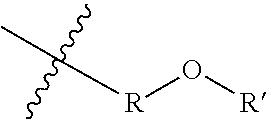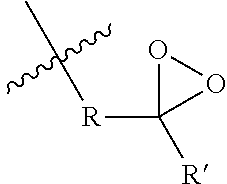Hydrocarbon transformations using carbocatalysts
a technology of carbocatalysts and hydrocarbons, which is applied in the direction of hydrocarbon by saturated bond conversion, physical/chemical process catalysts, bulk chemical production, etc., can solve the problems of prohibitively high cost of goods and services required for the manufacture of certain high-value organic chemicals, and achieves cheap and efficient effects, wide synthetic utility
- Summary
- Abstract
- Description
- Claims
- Application Information
AI Technical Summary
Benefits of technology
Problems solved by technology
Method used
Image
Examples
example 1
Preparation of Graphene Oxide or Graphite Oxide Catalyst
[0569]The graphene oxide or graphite oxide used in some experiments contained in these examples was prepared according to the following method.
[0570]A modified Hummers method was used to prepare the graphite oxide. Surface-modified graphene oxide or graphite oxide (MG) is prepared by reacting flake graphite with potassium permanganate (KMnO4) in concentrated sulfuric acid (H2SO4) at 35° C. for a period of 4 h. The reaction mixture is then quenched by dilution in deionized water followed by the addition of aqueous hydrogen peroxide (H2O2). The MG is insoluble in this mixture and is recovered by vacuum filtration followed by washing with excess water to remove residual metal salts and acid. Finally, the hygroscopic product is dried under vacuum to remove residual water affording the product as a dark brown powder. The mass balance of the reaction is described in FIG. 1. Optionally, the ratio of graphite to KMMnO4 and H2SO4 may be...
example 2
[0571]A 250 mL reaction flask is charged with natural flake graphite (1.56 g; SP-1 Bay Carbon Inc. or Alfa Aesar [99%; 7-10 μm]), 50 mL of concentrated sulfuric acid, 25 mL fuming nitric acid, and a stir bar, and then cooled in an ice bath. The flask is then charged with NaClO3 (3.25 g; note: in some cases NaClO3 is preferable over KClO3 due to the aqueous insolubility of KClO4 that may form during the reaction) under stirring. Additional charges of NaClO3 (3.25 g) are performed every hour for 11 consecutive hours per day. This procedure is repeated for 3 d. The resulting mixture is poured into 2 L deionized water. The heterogeneous dispersion is then filtered through a coarse fitted funnel or a nylon membrane filter (0.2 μm, Whatman) and the isolated material is washed with additional deionized water (3 L) and 6 N HCl (1 L). The filtered solids are collected and dried under high vacuum to provide a product (3.61 g) as a dark brown powder.
example 3
Preparation of Graphene Oxide
[0572]A graphene substrate is provided in a reaction chamber. The substrate does not exhibit one or more FT-IR peaks at 3150 cm−1, 1685 cm−1, 1280 cm−1 or 1140 cm−1. Next, plasma excited species of oxygen are directed from a plasma generator into the reaction chamber and brought in contact with an exposed surface of the graphene substrate. The graphene substrate is exposed to the plasma excited species of oxygen until an FT-IR spectrum of the substrate shows one or more peaks at 3150 cm−1, 1685 cm−1, 1280 cm−1 or 1140 cm−1.
PUM
| Property | Measurement | Unit |
|---|---|---|
| pores diameters | aaaaa | aaaaa |
| pores diameters | aaaaa | aaaaa |
| pore diameters | aaaaa | aaaaa |
Abstract
Description
Claims
Application Information
 Login to View More
Login to View More - R&D
- Intellectual Property
- Life Sciences
- Materials
- Tech Scout
- Unparalleled Data Quality
- Higher Quality Content
- 60% Fewer Hallucinations
Browse by: Latest US Patents, China's latest patents, Technical Efficacy Thesaurus, Application Domain, Technology Topic, Popular Technical Reports.
© 2025 PatSnap. All rights reserved.Legal|Privacy policy|Modern Slavery Act Transparency Statement|Sitemap|About US| Contact US: help@patsnap.com



